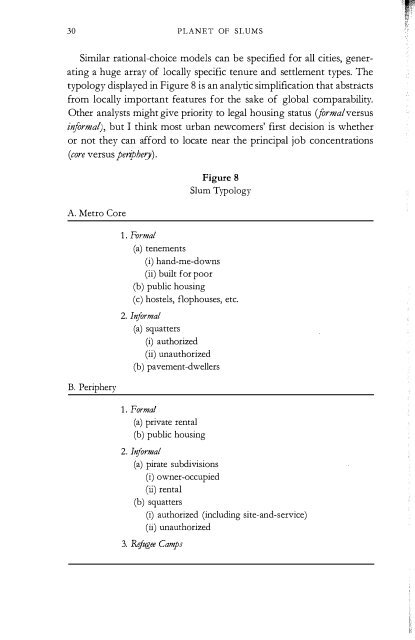Untitled - Rebel Studies Library
Untitled - Rebel Studies Library
Untitled - Rebel Studies Library
You also want an ePaper? Increase the reach of your titles
YUMPU automatically turns print PDFs into web optimized ePapers that Google loves.
30 PLANET OF SLUMS<br />
Similar rational-choice models can be specified for all cities, generating<br />
a huge array of locally specific tenure and settlement types. The<br />
typology displayed in Figure 8 is an analytic simplification that abstracts<br />
from locally important features for the sake of global comparability.<br />
Other analysts might give priority to legal housing status (formal versus<br />
inJormaf), but I think most urban newcomers' first decision is whether<br />
or not they can afford to locate near the principal job concentrations<br />
(core versus periphery).<br />
A. Metro Core<br />
B. Periphery<br />
1. Formal<br />
(a) tenements<br />
(i) hand-me-downs<br />
(ii) built for poor<br />
(b) public housing<br />
Figure 8<br />
Slum Typology<br />
(c) hostels, flophouses, etc.<br />
2. Informal<br />
(a) squatters<br />
(i) authorized<br />
(ii) unauthorized<br />
(b) pavement-dwellers<br />
1. Forma!<br />
(a) private rental<br />
(b) public housing<br />
2. Informal<br />
(a) pirate subdivisions<br />
(i) owner-occupied<br />
(ii) rental<br />
(b) squatters<br />
(i) authorized (including site-and-service)<br />
(ii) unauthorized<br />
3. Refugee Camps<br />
THE PREVALENCE OF SLUMS 31<br />
In the First World, of course, there is an archetypal distinction<br />
between "donut" -shaped American cities, with poor people concentrated<br />
in derelict cores and inner suburbs, and European "saucer" cities,<br />
with immigrant and unemployed populations marooned in highrise<br />
housing on the urban outskirts. The American poor, so to speak, live on<br />
Mercury; the European poor, on Neptune or Pluto. As Figure 9 illustrates,<br />
Third World slum-dwellers occupy a variety of urban orbits, \vith<br />
the greatest concentration in lowrise peripheries. In contrast to Europe,<br />
public housing for the poor in the South is an exception - Hong Kong,<br />
Singapore, China - rather than the rule. Somewhere between one fifth<br />
and one third of the urban poor live within or close to the urban core,<br />
mainly in older rental multifamily housing.<br />
1. Inner-City Poverty<br />
In North American and European cities, there is a basic distinction<br />
between "hand-me-down" housing, such as Harlem brownstones and<br />
Dublin Georgians, and built-for-the-poor tenements, such as Berlin's<br />
Figure 9<br />
Where the Poor Live39<br />
(percent of poor population)<br />
Inner-city slums Peripheral slums<br />
Karachi 34 66<br />
Khartoum 17 83<br />
Lusaka 34<br />
66<br />
Mexico City 27<br />
73<br />
Mumbai 20 80<br />
Rio de Janeiro 23 77<br />
39 Keith Pezzoli, "Mexico's Urban Housing Environments," in Brian Aldrich and<br />
Ranvinder Sandhu (eds.), Housing the Urban Poor: Policy and Praaice in Developing<br />
Co untries, London 1995, p 145; K. Sivaramakrishnan, "Urban Governance: Changing<br />
Realities," in Michael Cohen et aI., (eds), Preparingfor the Urban Futur e: Global Pressures<br />
and Local Fo rces, Washington, nc. 1997, p. 229; Mariana Fix, Pedro Arantes, and<br />
Giselle M. Tanaka, "Sao-Paulo, Brazil," UN-HABITAT Case Study, London 2003,<br />
p. 9; Jacquemin, Urban Development and New To wns in the Third Wo rld, p. 89.


